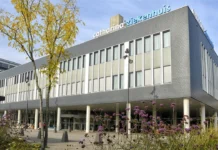Drawing the organs of individual breast cancer patients and then making exact radiation plans can be done much faster by using artificial intelligence models. With AI, it remains just as reliable and accurate. “And the time saved is crucial for the long term,” says researcher Nienke Bakx.
She has been conducting research at the Catharina Hospital for the past few years. On Thursday, she received her PhD from the Eindhoven University of Technology (TU/e). Thanks to the newly developed AI models, the drawing of tumours and surrounding organs for breast cancer patients can be done largely automatically. Until two years ago, this was done with ‘old-fashioned’ manual work.
Once the anatomy of the individual patient was visualised, the radiation plan – how best to deliver radiation to destroy cancer cells while sparing healthy organs – could be created. This too was done manually.
Half an hour
After a successful pilot, it was put into practice in May 2022. With the caveat that the radiotherapists and lab technicians check everything, adjust it if necessary and give their approval. Bakx: “When automatically drawing the organs, you see the greatest time savings, about sixty per cent of the time. For drawing the tumour, about forty per cent. If you express it in minutes, it saves half an hour per patient.”
In addition to drawing tumours and organs, AI models can also be used to create the radiation plan itself. Here too, the use of artificial intelligence proved to be a success: in 74 per cent of cases, the AI model was able to create a radiation plan that was immediately usable. With minor adjustments, this percentage rose to 86 per cent.
Work pressure
“Healthcare in the Netherlands is under pressure due to the ageing population, the increasing number of cancer patients and the shortage of staff, Bakx judges. “In Eindhoven we are still doing well, thanks to the study of medical imaging and radiotherapy techniques at Fontys, but at many hospitals you see vacancies that are not being filled. It is therefore essential that we do something about this, because otherwise the workload will become too great.”
She knows how to interpret the current times beautifully. “What is actually happening with AI now: we need more people to develop these kinds of models, but in the long run we will need fewer medical people. I see this period and all the work we do in it as investing in a sustainable solution for healthcare.” The success of the AI models in breast cancer has led to expansion to, for example, esophageal and lung cancer.
Source: Studio040
For Eindhoven News: Lila Mehrez
















